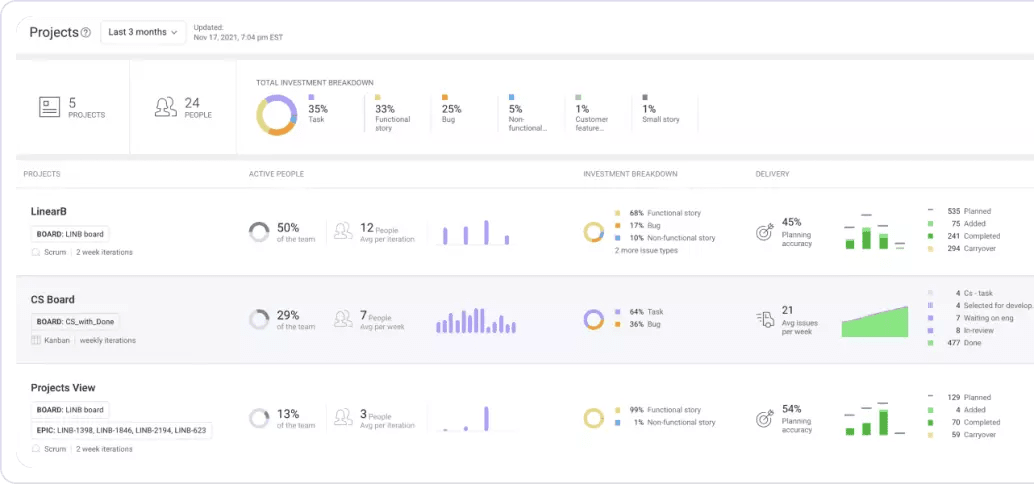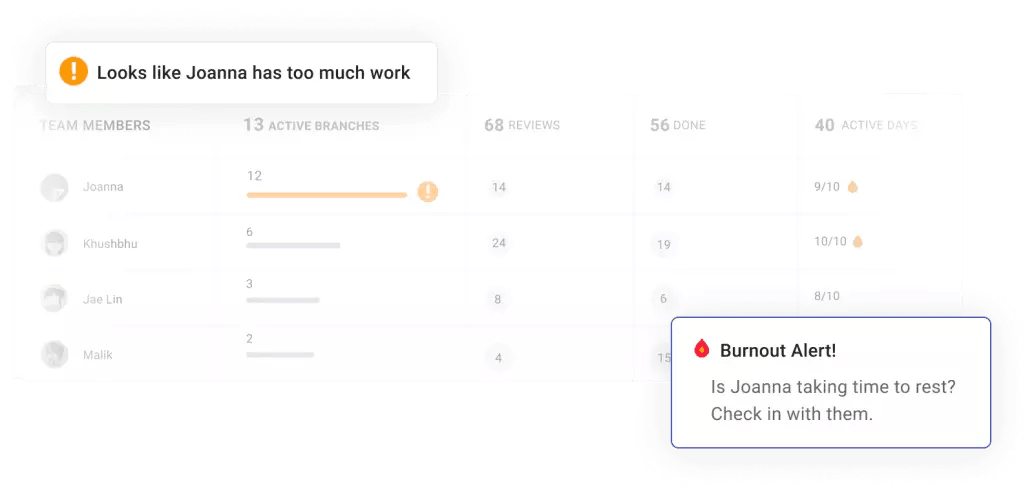Meetings.
The word alone makes people sigh.
But, when done right, meetings can be engaging and productive. They can accomplish what they’re meant to: Help people share information, collaborate, and come up with better ideas than any one person could come up with on their own.
In Scrum, meetings are called ceremonies. No, this isn’t just a euphemism to try and make people not realize that they’re in meetings! They’re called ceremonies because they have specific structures, processes, and goals that ensure that they are worth the time they take.
In this post, we’re going to look at how elite teams conduct the five Scrum ceremonies as well as look at how LinearB’s platform can be leveraged to make each one successful.
Let’s jump in!
1. Backlog Refinement
Between sprints, the product owner needs to update the product backlog. User stories may have been completed in the last sprint – or not completed and they need to be returned to the backlog. New requirements may have come in. There may have been changes to the product introduced by other teams. All of these will impact your product backlog items.
Most importantly, the relative priority of each item in the backlog must be up-to-date. This ensures that during Sprint Planning, the next ceremony, the team picks the right things to work on. (To learn more about the backlog refinement meeting, be sure to check out our full guide on it.)
A Scrum board is an essential tool to manage your backlog. But it is by no means the only project management tool you should be using in a Scrum framework. LinearB’s Project Delivery Tracker links the code that your team creates to the projects, epics, and issues that they’re working towards. This enables you to answer questions like: Where did the team spend their time? Why did we not achieve what we planned? Are we accurately assigning story points?
 Your CEO will love this! You can see your team’s investment profile, project allocation, and planning accuracy by boards, epics, labels or custom fields. Learn more about Project Delivery Tracker.
Your CEO will love this! You can see your team’s investment profile, project allocation, and planning accuracy by boards, epics, labels or custom fields. Learn more about Project Delivery Tracker.
Insights like these allow you to make your backlog more accurate, so that you can better plan your sprints and actually deliver what you plan to deliver.
2. Sprint Planning
The name really says it all. In the Sprint Planning ceremony, you plan the upcoming sprint. You start by taking your up-to-date product backlog and deciding which items to move over to your sprint backlog and work on. You then define your sprint goals, so that once the sprint is over, you can evaluate how well you did.
It’s notoriously difficult to take on just the right amount of work. Too little and you’re not achieving as much as you could. Too much and you could end up being a bottleneck that is holding up other teams.
You can use LinearB’s Project Delivery Tracker to see how well you planned past sprints. Our Planning Accuracy metric tells you how much of your planned work you actually completed during a sprint. This feedback allows you to see whether you tend to over or underestimate how much you can complete so that you can plan more accurately.
There’s also the People Metrics dashboard, which tells you how much work each person took on in previous sprints and what they worked on exactly. This individual-level data enables you to make sure that members of your team are not taking on too much and overworking themselves. LinearB will even let you know if someone is at risk of burning out.

During the Sprint Planning meeting, it’s easy to jump right into the details and start figuring out who is going to take on which items. But, it’s crucial to stay higher-level and discuss the goals of the sprint. Everyone on the team should understand why they are working on what they are working on.
For Maria Gutierrez, VP of Engineering at Twitter, this big picture is essential not just for successful sprints but for a sustainable engineering process:
By connecting all of your development data – like projects, epics, issues, and branches as well as who is working on what – LinearB makes it easy to get the larger context.
3. Daily Scrum
The Daily Scrum (also called the Scrum Standup or Daily Standup because you should do it standing up) is supposed to be a simple and quick team meeting — ideally, it should be time boxed for 15 minutes. The main goal is to make sure that everyone is aligned on what they’re going to be working on over the next 24 hours.
You should go around and each person should answer three questions:
- What did I work on yesterday?
- What am I working on today?
- What issues are blocking me?
This allows each member of the development team to know what everyone is working on, so that they understand how their own work fits into the larger whole. People can also pose questions and help other team members overcome blockers.
LinearB’s Pulse Dashboard is a powerful complement to the Daily Scrum. You can use the Pulse Dashboard to see exactly how much progress the team has made, overall and against individual issues. This is especially valuable to the project owner and Scrum manager, who otherwise have to gauge progress based on the updates each person shared out loud during the Daily Scrums, which is imprecise, qualitative data.
 Check out this awesome dashboard we use for our standup. It identifies who’s blocked, who has too much WIP, and if our work is aligned with the business priorities. Learn more about Pulse!
Check out this awesome dashboard we use for our standup. It identifies who’s blocked, who has too much WIP, and if our work is aligned with the business priorities. Learn more about Pulse!
It should be said that you should use the Pulse Dashboard before or after a Daily Scrum but not during. The Daily Scrum is time for your team to connect with one another each day. This not only promotes alignment, but it also helps to build camaraderie and helps everyone truly feel part of a team. That’s why the Daily Scrum should be spent talking face-to-face, not going through an external tool like the backlog or the Pulse Dashboard.
For more tips on how to improve your Daily Standup, be sure to check out our super-popular article, 16 Ways To Make Your Daily Stand-Up Better With LinearB.
4. Sprint Review
There are two ceremonies to hold once a sprint is over. The first is the Sprint Review. A key piece the review ceremony, although by no means the only piece, is something very much like “show and tell.” Each person presents to the whole team what they completed during the sprint. This allows everyone to know what changes have been introduced to the application and celebrate one another’s hard work and achievements!
The Sprint Review meeting should be casual and fun, like a little party at the end of each sprint that rallies the team for the next one!
The Project Delivery Tracker is of great value here. It tells you which bits of work were completed and how each person’s individual work culminated in the completion of larger issues and projects. It enables everyone to see the full value of the work that they did.
5. Sprint Retrospective
The second post-sprint ceremony is the Sprint Retrospective. Its purpose is to identify what went well and what can be improved in future sprints.
Retrospectives can be challenging for Scrum teams because they require people to point out places where they or their teammates did not do a good job. It’s crucial to create a culture in these meetings in which people can be honest and vulnerable. It’s a good idea to reiterate at the beginning of each Retrospective that the goal is not to point fingers. The goal is to help the team build on their successes and do even better next time.
The Project Delivery Tracker can serve as an objective report for your sprint. How well did you plan? Where did you end up spending a lot of time? Which issues were neglected? Was the work distributed fairly? You can answer all of these questions, and so many others, simply by consulting the Project Delivery Tracker.
This is not to say that the PDT should replace the Sprint Retrospective. Instead, view the PDT as a conversation starter. Members of the team can fill in the gaps, add context, and share their reflections on what is captured in the PDT.
Conclusion
Each of the five Scrum ceremonies is crucial to the Scrum process. But like with any meeting, they easily become a source of annoyance instead of value.
By adhering to the guidelines laid out in this piece, you can make sure that your ceremonies are efficient, effective, and ultimately help you accomplish the end goal: Ship better code faster.
And that’s what LinearB is all about. With features like the Product Delivery Tracker, the Pulse Dashboard, and People Metrics, LinearB can not only enhance your Scrum ceremonies but also the entire way your team plans, writes, and ships code.






